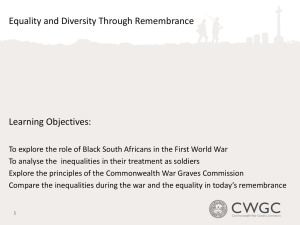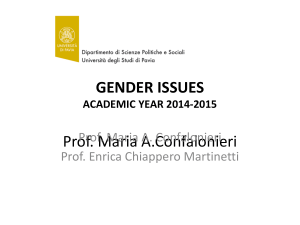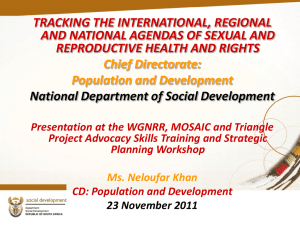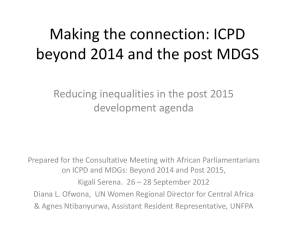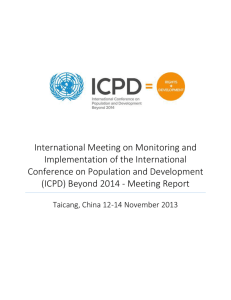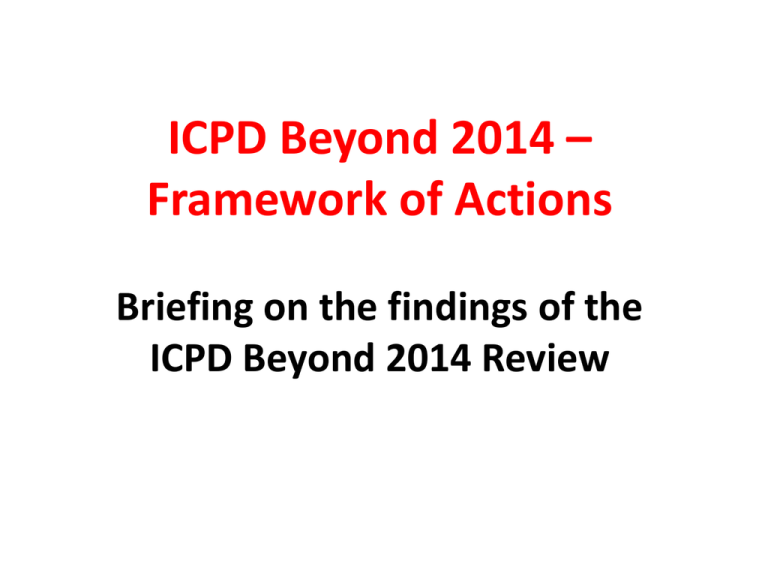
ICPD Beyond 2014 –
Framework of Actions
Briefing on the findings of the
ICPD Beyond 2014 Review
1994 ICPD Consensus
Increasing social, economic and political
equality, including sexual and reproductive
health and rights, is the basis for individual
well-being, lower population growth, and
sustainable development.
The evidence of the Review overwhelmingly
supports that consensus.
ICPD Beyond 2014
•
•
•
•
•
Substantial Achievements
Unequal Progress
New Challenges & Opportunities
Fragmented Implementation
Re-affirming the ICPD Programme of Action core
message:
….that investing in individual human rights,
capabilities and dignity – across multiple sectors
and throughout the life-course – is the foundation
of sustainable development.
Thematic Pillars for
Population & Development Post-2014
Cross-Cutting Issues
• Human Rights
• Equality
Cross-Cutting: Human Rights
Affirming the rights & freedoms set forth in the
Universal Declaration of Human Rights, without
distinction of any kind.
Throughout, the Report highlights progress in
International & Regional human rights since ICPD…
Yet gaps remain in the equitable application to all
persons.
Cross-Cutting: Equality
“The relationship of population to development is
so intertwined with issues of poverty, patterns of
production and consumption, and inequality, that
none can be fruitfully addressed in isolation.”
ICPD Programme of Action, 1994
No less critical today.
The Review clearly underscores the unfulfilled
realization of equality in income, wealth,
educational attainment, health, or opportunity.
Methods & Sources
Global Survey of 176 governments:
– Elaboration of Institutions, Laws, Policies
– Commitments made over the past 5 years
– Priorities for the next 5 years
Regional Conferences
Three Thematic Meetings: youth, human rights, women’s
health
Meeting on Monitoring ICPD Beyond 2014
National data on outcomes (Population Division, DHS,
MICS, WHO, UNAIDS, UNICEF, et al)
DIGNITY &
Dignity
HUMAN RIGHTS
•
•
•
•
Wealth
Education
Employment
Discrimination
•
•
•
•
•
•
Women
Adolescents and Youth
Older Persons
Persons with Disabilities
Indigenous Peoples
Non-discrimination
applies to all persons
Global Wealth Pyramid (Credit Suisse 2012)
In 2012
approximately
8% of adults
controlled over
80% of the
world’s wealth
> USD 1 m
USD 100,000 to 1 m
32 m
(0.7%)
361 m
(7.7%)
USD 10,000 to 100,000
USD 98.7 trn (41%)
USD 101.8 trn (42.3%)
USD 33 trn (13.7%)
1,066 m
(22.9%)
< USD 10,000
USD 7.3 trn (3%)
3,207 m
(68.7%)
Wealth
Number of adults (percent of world population)
Total wealth
(percent of
world)
53% of all gains in global income to
top 5% of earners 1988-2008
Cost of Inequality
• Diversion of the world’s wealth – and finite
natural resources – to a small fraction of the
population
– Limits resources for poverty reduction & sustained
growth
• Limits political access for some, when assets
define influence
• Reduces social cohesion, upward mobility,
empathy, and shared responsibility
Women’s Empowerment & Gender Equality
Gender gap in labor force participation narrowed slightly
since 1994, but women are still:
–
–
–
–
Paid less than men for equal work
Over-represented in vulnerable, informal employment
Under-represented in positions of power
Carrying a disproportionate share of unpaid domestic work
Gender-based violence demands urgent attention
– 1 in 3 women report physical/sexual abuse
– 1 in 4 men in a 10,000 person multi-country study in Asia &
Pacific admitted to perpetrating rape
Government priorities for gender equality and women’s empowerment: economic
empowerment and employment (71%), political empowerment and participation
(59%) and the elimination of all forms of violence (56%).
Support for gender equality by region
2004-2009
Per cent
University
education
90
80
70
Business
executives
60
50
40
Political
leaders
30
20
10
Africa
Asia
Eastern
LAC
Japan
United States
Australia
France
Spain
Great Britain
Italy
Finland
Germany
Canada
Netherlands
Switzerland
Norway
Andorra
Sweden
Argentina
Brazil
Mexico
Trinidad and Tobago
Uruguay
Peru
Russian Federation
Romania
Ukraine
Moldova
Bulgaria
Poland
Serbia
Slovenia
Jordan
Iran
Malaysia
Georgia
India
Turkey
Indonesia
South Korea
Viet Nam
China
Thailand
Cyprus
0
Egypt
Mali
Ghana
Burkina Faso
Morocco
South Africa
Support for gender equality
100
Right to a job
West Europe &
The report presents new findings from the World Values Survey showing that public attitudes to gender equality vary greatly between
countries, and region. Respondents in most counties agree that both girls and boys deserve equal access to a university education, but when
asked whether girls and boys have equal rights to a job – many countries disagree.
Support for gender equality
“Men make better political leaders than women”
Proportion who disagree - 1995-2005
Since the 1990’s, an increasing proportion of people disagree that “men make better political leaders than women” , showing growing support
for gender equality (from analysis of World Values Survey data).
% of Governments Addressing Equality
in Work & Family Life? (Global Survey 2012)
85%
64%
90%
54%
41%
Commitments or laws against workplace
discrimination of women
Policy commitments to work/family
balance
Maternity leave
Paternity leave
Breastfeeding in the public workplace
~ All 5 policies & provisions? 18.7% (26/113)
A rising proportion of older persons
(60+ years), 1950-2050
40%
Africa
35%
Americas
30%
25%
Asia
20%
Europe
15%
Oceania
• 11% globally, rising in all
regions
• > 40% of persons 65+ in
Africa economically active
• Illiteracy high (25% in LA,
68% in Africa) – higher
among women
10%
World
5%
2050
2040
2030
2020
2010
2000
1990
1980
1970
1960
1950
0%
ANTICIPATE: Pensions, health
care, innovative housing,
social protection, lifelong
learning, flexible employment
The demographic importance of
young people 10-24 yrs, 1950-2050
35%
30%
Africa
25%
Americas
20%
Asia
Europe
15%
Oceania
10%
World
• Primary school
enrollment rates
approaching 90%,
secondary far from
universal
• Of 197 million people
unemployed, nearly
40% are age 15-24
5%
2050
2040
2030
2020
2010
2000
1990
1980
1970
1960
1950
0%
• 600 million productive
jobs needed over the
next decade
Invest in Adolescents & Youth
• 34% of women 20-24 in developing regions are married
or in union by age 18; 12% by age 15
• Early marriage leads to early fertility: 1 in 5 girls in
developing countries become pregnant before age 18
• Higher levels of education delay marriage, fertility
Investments are critically needed to ensure quality health
and education, freedom from early marriage &
childbearing, opportunities for safe paid work, and political
participation.
Government priorities for young people: economic empowerment and employment
(70 %), social inclusion and education (56 %)
Stark Health & Wealth Inequalities for
Indigenous Peoples
Life expectancy of indigenous vs. non-indigenous children:
• 20 years in Nepal or Australia
• 13 years in Guatemala
• 11 years in New Zealand
Among 28 million indigenous people in Latin America
almost no change in poverty (~80%) from early 1990’s to
early 2000’s, and poverty among indigenous…
• 8x non-indigenous in Paraguay
• 6x … Panama
• 3x …Mexico
Unequal Burden of Disability
• 5% age 0-14 live with a disability
• 15-20% over age 15 live with disability
• Rising dramatically with age – and increasing
due to population aging, rise in years lived
with non-communicable diseases
• Women more than men
• Higher in lower income countries
Non-Discrimination Must be
Universally Applied
• Ethnic and Racial Minorities
• Persons of Diverse Sexual Orientation and
Gender Identity
• Persons Living with HIV and AIDS
• Migrants
• Sex Workers
• ……….many others
Social Cost of Discrimination
Even without physical violence, stigma and stereotype
threat leads to loss of human health and productivity:
• negative birth outcomes
• higher depression and anxiety
• lower performance on aptitude tests and productivity
World Values Survey data highlights national differences
in discriminatory attitudes:
• where greater intolerance, directed towards multiple
population groups
Key Areas for Future Action:
Dignity & Human Rights
1. Wealth and income inequalities are increasing
2. Empowerment of women and gender equality
remain unfulfilled
3. Lifelong learning, and building human
capabilities, warrants substantial investment –
especially for young people
4. Eliminate discrimination and marginalization
Dignity
HEALTH
• Spatial &
• Social Inequalities
• 47% decline in maternal
mortality
• Rising Use of Contraception
• Unsafe Abortion Continues
• Challenge of STIs
• Gaps in young people’s SRH
• Comprehensive Sexuality
Education is more effective
with attention to gender
Changes in Global Health 1990-2010
1. Life expectancy increased from 64.8 years in 199095 to 70 years by 2010-2015 (5.2 years)
2. Under-5 mortality rate dropped from 90 deaths per
1,000 live births in 1990 to 48 in 2012
3. Dramatic shifts in global health burden towards
non-communicable diseases (NCDs) and injuries
4. But - persistence of communicable, maternal,
nutritional and neonatal disorders in sub-Saharan
Africa, South Asia
Contraceptive Prevalence Rate (CPR) increased
~ 10% world-wide, 1990-2010
Percentage of married (or in union) women 15 – 49 years who are using modern method of contraceptive, 1994 and 2014
80
North America
Latin America/Caribbean
Asia
Europe
60
World
Oceania
40
Africa
20
0
1994
2014
Source: UN Department of Economic and Social Affairs, World Contraceptive Use 2012
Good progress: Absolute & Relative Gains in CPR
Good progress: Absolute & Relative Gains in CPR
Country example
Country example
Country example
Country example
0
20
20
40
40
60
60
80
80
100
100
Country example
Country example
0
1990
1995
100
1990
1995
2000
2005
2000
2005
Country
example
2010
2010
1990
1990
1995
1995
2000
2000
2005
2005
80
100
Country example
60
80
Richest 20%
Fourth 20%
Richest 20%
40
60
Middle 20%
Fourth 20%
20
40
Second 20%
Middle 20%
Poorest 20%
Second 20%
0
20
Poorest 20%
1995
2000
2005
2010
0
1990
1990
1995
2000
2005
2010
Source: MDG5b+ Database and additional analysis, UNFPA
2010
2010
1990
1990
1995
1995
2000
2000
2005
2005
2010
2010
Stagnancy / increasing inequalities in CPR
Country example
Country example
Country example
Country example
0
0
20
20
40
40
60
60
80
80
100
100
Country example
Country example
1990
1990
1995
2000
1995
2000
2005
2005
2010
2010
1990
1990
1995
1995
2000
2005
2000
2005
80
80
100
100
Country example
Country example
Richest 20%
60
60
Richest 20%
Fourth 20%
Fourth 20%
Middle 20%
40
40
Middle 20%
Second 20%
Second 20%
Poorest 20%
0
0
20
20
Poorest 20%
1990
1990
1995
1995
2000
2000
2005
2005
2010
2010
Source: MDG5b+ Database and additional analysis, UNFPA
2010
2010
1990
1990
1995
1995
2000
2000
2005
2005
2010
2010
Skilled Birth Attendance increased
~ 19% worldwide, 1990-2010 (DHS, MICS)
Percentage of women who had a skilled attendant (doctor, nurse or mid-wife) at birth, 1990 and 2010
100
Eastern Asia
Latin America/Caribbean
Northern Africa
80
Western Asia
South Eastern Asia
World
60
Southern Asia
sub-Saharan Africa
40
20
0
1990
2010
Source: UN Millennium Development Goals 2012 Report Statistical Annex
In some countries, good progress: Absolute & relative gains in use
of Skilled Attendance
Country example
Country example
0
20
40
60
80
100
Country example
1990
1995
2000
2005
2010
1990
1995
2000
80
100
Country example
60
Richest 20%
Fourth 20%
40
Middle 20%
Second 20%
0
20
Poorest 20%
1990
1995
2000
2005
Source: MDG5b+ Database and additional analysis, UNFPA
2010
2005
2010
1990
1995
2000
2005
2010
In select countries, stagnancy or increasing inequalities in
the use of Skilled Attendance
Country example
Country example
0
20
40
60
80
100
Country example
1990
1995
2000
2005
2010
1990
1995
2000
80
100
Country example
60
Richest 20%
Fourth 20%
40
Middle 20%
Second 20%
0
20
Poorest 20%
Source: MDG5b+ Database and additional analysis, UNFPA
1990
1995
2000
2005
2010
2005
2010
1990
1995
2000
2005
2010
Abortion
• Decline in deaths due to abortion from 50 to
30 deaths for every 100,000 unsafe abortions
• Yet death rates in Africa and Asia still 460 and
160 deaths per 100,000 unsafe abortions
• In countries where abortion is rare and safe:
– It is legal & accessible
– Modern contraception is widely available
– Young people have access to comprehensive sexuality
education
– Gender equality is more fully realized
Sexually Transmitted Infections
have risen - weak surveillance
• WHO reports 40% rise in STI incidence
(trichomoniasis, gonorrhea) over the past 20
years – (esp Latin America, SSA)
• But monitoring is extremely weak outside the
wealthiest countries
• Better diagnosis and surveillance of STIs is
sorely needed throughout the world
HIV is far from
eradicated
• 33% global decline new
HIV infections
• But decline in
preventive behavior in
some countries
• Delayed infection in
southern Africa
• Only 34% of eligible
patients get ART
• Access to ART continues
to favor adults over
children
• HIV is rising in Eastern
Europe, Central Asia
World Bank 2011
Proportion of births assisted by trained providers
(midwives/nurses/doctors) is rising,
but not in sub-Saharan Africa
Lay person
Traditional birth
attendant
Midwives/nurses/
doctors
Percentage of births
100
80
60
40
20
0
2000
2005
Sub-Saharan
Africa
2015
2000
2005
2015
South and South-East
Asia
2000
2005
2015
Middle East,
North Africa
and Central Asia
2000
2005
2015
Latin America
and the Caribbean
Poor monitoring of young people’s
access to SRH & CSE
• Limited SRH service data available for youth
yet…
– Women < 25 yrs account for ~50% of deaths from
abortion
– Persons 15-24 yrs account for 41% of new HIV
infections worldwide in 2009
• Comprehensive Sexuality Education (CSE)
evaluations suggest that addressing gender
and power leads to better health outcomes
Key Areas for Future Action
Health
1. Health systems need innovative strengthening to
ensure universal access to quality SRH
–
–
–
–
human resources
information systems for continuity of care
rural and urban service linkages
HIV and SRH services need to be fully integrated
2. Improve access to SRH & CSE for young people,
including age 10-14, address gender
3. Strengthen STI diagnostics, treatment,
surveillance
4. Start building systems for reproductive cancers,
NCD, elder care
PLACE
& MOBILITY
Dignity
• Spatial & Social
Inequalities
• Household structures
are changing
• Urbanization is growing
• International migration
has diversified
• Many suffer from
insecurity of place
Changes in living arrangements,
households
• Single-person households are rising in all regions
outside of Africa
• Persons never married has risen across a majority
of countries of Europe, Oceania and the Americas
• Proportion of persons divorced or separated has
increased
• Single parent households are rising – not in all
regions – and these households are primarily
headed by women
Rising proportion of one-person households in
select countries 1990-2010
(IPUMS)
Urbanization
• In 2008, for the first time, more than half the
world’s population became urban
• 90% of urban population growth in the past 20
years occurred in developing countries
• Cities & towns gaining an estimated 1.3 million
persons per week – due to migration & fertility
• Young adults account for a large proportion of
urban migrants
Total Population by City Size,
1970, 1990, 2011, 2025
Potential Benefits of Urbanization
• Cities and towns are responsible for over 80%
of GNP worldwide
• Can reduce energy demand – by concentrating
transport, housing, IT
• Provides economies of scale for health, welfare
and education systems
• Offers autonomy, mobility, participation
• But potential not assured – urban inequalities
heighten vulnerability, risk and exclusion
Greater Diversity in
International Migration
• International migrants (232 million) have increased,
but not as a proportion of the world population
(3.2%)
• More countries involved – as points of origin,
destination, transit
• As much migration is occurring between developing
countries (82.3 million) as from developing to
developed countries (81.9 million)
• Approximately half of all international migrants are
now women (48%) – more travelling alone, as heads
of households
Millions without Security of Place
• 28.8 million displaced due to conflict, violence
or human rights violations in 2013, surpassing
the prior peak in 1994
• 32.4 million displaced due to natural disasters
• 865 million living in slums
• No reliable count of those suffering forced
evictions - 2.5 to 15 million per year?
• An uncounted number of people are homeless,
inadequately housed, or at imminent risk of
becoming homeless
Key Areas for Future Action:
Place & Mobility
1. Policies should take into account that
household structures and living arrangements
are increasingly diverse
2. The world must plan and build sustainable
cities, and strengthen rural-urban linkages
3. International migrants need greater security,
and governments should increase cooperation
4. Those with insecurity of place (Homelessness,
Displacement) are poorly counted
GOVERNANCE &
Dignity
ACCOUNTABILITY
• Accountability
• Elaboration of Institutions
• Mechanisms for Oversight,
Human Rights Protection
& Redress
• Participation
• Knowledge Systems
• Partnerships & Resources
Government commitments to participation
varied for different population groups
Global Survey: % of Governments that report
they are committed to the participation of key
groups:
76%
73%
61%
47%
Adolescents and youth
Women
Persons with disabilities
Older persons
~ All 4 key population groups? 21.7% (30/138)
Knowledge Sectors are Weak in Many Countries
• Monitoring population dynamics is essential to
enhancing human rights, health and development,
yet collection and use of data are weak
• Only 109 of 193 member states have complete
coverage of birth registration
• Only about 1/3 of births in LDCs are registered
• Very weak data on migration, either internal or
international – and on those with insecurity of
place – e.g. IDPs, homeless
• Inadequate number of trained census experts and
demographers in developing countries
Partnerships & Resources
• Since 1994: number, diversity of donors increased
• The architecture for development cooperation
shaped by the urgent response to HIV/AIDS
• Funding for 4 costed ICPD components (FP; RH,
STI&HIV/AIDS; research, data, policy), increased in
absolute dollars – dominant share to HIV/AIDS
– HIV/AIDS received 66% of total assistance (2011)
– RH received 22%
• Global targets and accountability matter: the focus
on HIV& AIDS, and the MDGs, have had impact
Key Areas for Future Action:
Governance & Accountability
1. Population dynamics are critical to
development planning
2. Knowledge sectors need strengthening
3. More systematic, inclusive
participation
4. Better accountability systems for
national and global programs
Dignity
SUSTAINABILITY
From ICPD Beyond 2014 to • Diverse population
Post-2015
dynamics
• Threats of climate change
• Cost of inequality
• Paths Forward
Population, Consumption &
Climate Change
• Overall long-term population
growth matters to climate
change
• But the error habitually made
is to equate each new birth
with rising emissions
Population, Consumption &
Climate Change
1 person
1 unit of emission
Population, Consumption &
Climate Change
Greater attention needed:
• Innovation, technology for green economies
• Incentives to shift patterns of consumption
• Infrastructure investments at scale - for public
transport, housing, utilities, energy - can
potentially:
– Reduce emissions per capita
– Increase access and participation, thereby
reducing social & spatial inequalities
Paths toDignity
SUSTAINABILITY
1.
2.
3.
4.
5.
6.
7.
Dignity, Human Rights, Non-Discrimination for All
Lifelong investment in health & education,
particularly for young people
Universal access to SRHR
Security of Place, Safe Mobility
Sustainable, inclusive cities linked to rural areas
A fundamental change in patterns of consumption
Stronger global leadership and accountability

